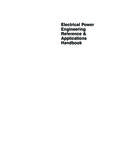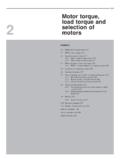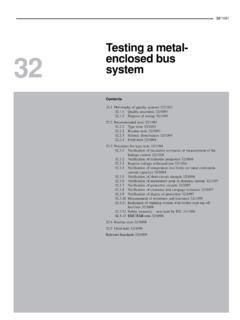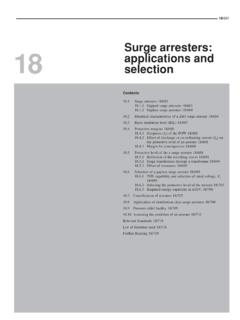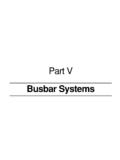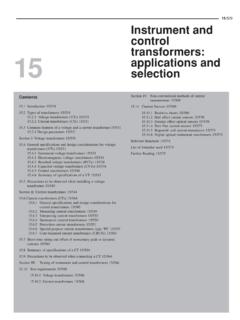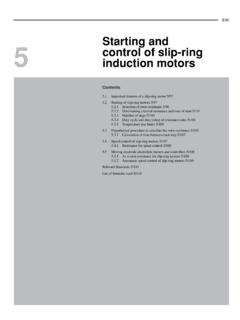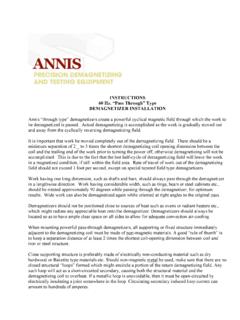Transcription of Contents
1 27 Selection of power reactors 27 magnetic characteristics 27 criterion and I-f characteristics of different types of reactors27 Air-cored or coreless type reactors 27 Gapped iron core or saturated type reactors 27 27 Shunt reactors or compensating reactors 27 Current limiting or series reactors 27 Damping reactors 27 Neutral grounding reactors 27 Grounding transformer or neutral couplers 27 Arc suppression or Petersen coil (reactor) 27 Tuning or filter reactors 27 Smoothing reactors 27/980 Relevant Standards 27/98027 Selection ofpower reactors27/971 Selection of power reactors27 IntroductionMaintaining quality of power in terms of voltage andcurrent waveforms (having low harmonic distortions anda stable voltage) is not only obligatory on the part ofutility companies to provide quality power to their users,it is also mandatory on the part of utility companies aswell as the users to meet the norms of EMC/EMI asdiscussed in Section Power reactor is a simpleand a handy tool to tackle these problems as discussed atdifferent places in this book.
2 Like for electronic circuitsin Section by way of smoothing current and voltageover-shoots (di/dt and dv/dt controls respectively),suppressing harmonics at source using harmonic filters(Section ) or providing reactive support to a powernetwork (Section ) reactors are similar to transformers. However,they have only one winding per phase and can berepresented as shown in Figure They are employedto perform a number of functions, primarily to controland regulate the reactive power of a power system bysupplying the inductive and absorbing the capacitivepower. Control can be achieved in different ways as notedlater. The reactors, depending upon their design and I-fcharacteristics, can be classified as follows:1 Single- or three-phase Single-phase reactors are usedin the neutral circuit either to limit the ground faultcurrents or as arc-suppression coils (Section ).
3 Similarly, three-phase reactors are used for dry type and oil-immersed type Thiswill depend upon the size of the reactor and the designof the manufacturer. The latest practice is to use air-cooled dry type, which calls for lesser maintenanceand is free from any fire or outdoor types These may be designed indooror outdoor depending upon the facility Where necessary such as inreactive power management, the reactance of the coilcan be varied by providing an on- or off-load tap changinggear with the reactor, similar to a power Selection of power reactorsWhen it is required to limit the inrush current a fixedreactance (linear) reactor is more suitable. A variable typereactor will be necessary when it is to be used for voltageregulation or load sharing.
4 In circuits where harmonicsmay be present, saturated type reactors may be harmonic content may be measured throughharmonic analysers and expressed as a percentage of thefundamental component. The current and voltage ratingsof the reactors will depend upon their application. Aseries reactor connected permanently in the circuit, forinstance, will be rated continuously and for full systemvoltage, whereas a reactor used in the ground circuitmay be short-time rated and rated for the likely maximumground fault current and its magnetic characteristicsThe magnetic characteristics of an inductor coil will varywith the type of its configuration as discussed below. Itcan have one of the following shapes: Linear(Figure (a)) Non-linear (Figures (b1) and (b2)) Saturated(Figure (c))A reactor can be designed to provide any of thesecharacteristics to meet the different reactive power Design criterion and I-fffffcharacteristics of differenttypes of Air-cored or coreless type reactorsThese reactors can be made of copper or aluminiumwinding without any core, similar to an air-cored solenoid,as shown in Figure They are merely coils of wirewrapped around a non-metallic core.
5 The cores usuallyemployed are of ceramics, concrete, fibre glass or glasspolyester. In the absence of an iron core it causes a largeamount of leakage flux (stray magnetic field) in the space,which may also infringe with the metallic tank housingof the reactor, and affect the reactance of the coil, inaddition to heating the tank itself. It is therefore importantto provide some kind of shielding between the windingof the reactor and the tank. The shielding can be magneticor non- magnetic as discussed later. With shielding, thecharacteristics of an air core reactor can be alteredaccording to its application. When no shielding is providedsuch reactors provide linear I-f characteristics in theiroperating range, as shown in Figure (a).
6 In the absenceof an iron core, there is no saturation of the core. Thesereactors are more useful when they are required to beused as current limiting devices as for limiting the inrushcurrents during switching of large capacitor banks ( ). But they reduce the steady-state power transfercapability (/)12VZ of the system, as discussed in magnetic shieldingA magnetic circuit develops a stray magnetic field aroundit. A reactor, which is a magnetic circuit, at higher currentsfVFigure representation of a reactor27/974 Electrical Power Engineering Reference & Applications Handbooksuch as during switching operations or on faults developshigh magnitudes of stray fields around it that may linkmagnetic objects in the vicinity and cause high in them, as in nearby metallic structures andelectrical apparatus.
7 All this may result in high circulatingcurrents and consequent heating. In addition, it may alsoaffects the working and performance of the measuringand indicating instruments connected on the system. Toreduce such effects a magnetic frame performing a FaradayCage (Section ) made of steel laminations and rigidlyclamped to suppress vibrations and noise (magnetostrictioneffect) is provided around the inductor coil, as illustratedin Figure This frame arrests most of the spacemagnetic field within the close vicinity of the balance field will link the iron frame and would bealmost used up in magnetizing it. The steel frame iscalled the magnetic shield. The self-inductance of thecoil, L, is now much less affected.
8 The flux density ofthe core is designed so that it does not saturate up to150% of the rated increase in the fundamental value of the currentbeyond 150%, or a voltage drop across the coil of morethan 150% of the reactor voltage (this may occur in thepresence of harmonics) may, however, saturate the coreand reduce the reactance of the coil. Magnetically shieldedreactors therefore have limitations when the systemharmonics are high or when linear V-I characteristicsare desirable beyond 150% of the rated need for a magnetic shielding is greater in highcurrent reactors than in smaller ratings. For more detailson magnetic shielding see Section on segregatedphase bus non- magnetic shieldingIn non-magnetically shielded reactors a cylindrical shieldof non- magnetic material, such as aluminium or copper,is provided around the inductor coil instead of a magneticmaterial (Figure ).
9 Since there is no iron path for themagnetic field, the coil now may not maintain a constantinductive reactance, as in the case of magnetic , it may become reduced with an increase in thecurrent due to a counter-field generated in the coil by thenon- magnetic the theory of neutralization of the magnetic effecton the conductor in a non- magnetic shielding, refer tothe continuous enclosures for isolated phase bus systemsdiscussed in Section As a result of non-magneticshielding there will be no saturation of the non-magneticcore (inductor coil) and the V-I characteristic of the reactorwill remain almost types of reactors can now be used as magnetic fluxor reactancePeak currentPeak currentNon-saturatedNon-saturatedregion1 203 Peak current1304 Peak current1203(a) Linear(b1) Non-linear(b2) Non-linear(c) SaturatedSaturation knee-point for curve 1 Saturation knee-point for curve 2 Saturatedregion12 SaturatedregionSaturatedregionSaturation knee-pointNon saturatedregionSaturationknee-pointSatur ated regionNon-saturatedregion2 Figure characteristics of a reactorMagneticsteel shieldWindingsFigure air-cored magnetically shielded reactor(Faraday Cage)Selection of power reactors27/975limiting reactors and also as harmonic suppressors.
10 Theyare also recommended for capacitor application due totheir linear characteristic which will not disturb the tuningof the filter Gapped iron core or saturated typereactorsReactors of this type, as shown in Figure , tend tosaturate at lower currents (Figure (c)). The currentdrawn by them is too low, even up to the saturationlevel, due to high leakage reactance which can increaseto 100%. They therefore provide a high inductiveimpedance initially which becomes stabilized with satura-tion of the core. After saturation, the I-f characteristicFigure view of a magnetically shielded tankGroundingterminalMagneticshieldCoppe r woundcoilPressing plateTie rodCopper tankMagnetic shieldGrounding tankNon- magnetic shieldSpacerCopper wound coilPressure plateTie rod(non- magnetic ) tankTie rodCopper wound coilPressure plateGrounding terminalNon- magnetic shieldFigure view of non-magnetically shielded reactorSteellaminationsAir gapsNoteIt becomes air core whenthere is no iron gapped iron three-phase reactor27/976 Electrical Power Engineering Reference & Applications Handbookbecomes almost constant or flat.
